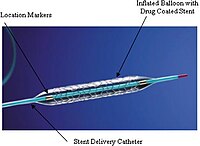
Photo from wikipedia
Over the last decade, drug-eluting stents (DES) have undergone substantial modifications with thinner struts and more biocompatible durable polymer (DP) or biodegradable polymer (BP). In DP-based DES, after drug elusion… Click to show full abstract
Over the last decade, drug-eluting stents (DES) have undergone substantial modifications with thinner struts and more biocompatible durable polymer (DP) or biodegradable polymer (BP). In DP-based DES, after drug elusion has been completed, DP remnants may trigger of local inflammatory vascular reactions and promote delayed healing, leading to accelerated neoatherosclerosis (NA). Thus, BPs have been developed to reduce the above-mentioned risks. Recently, poor strut coverage and in-stent NA are increasingly recognized the cause of late stent failure, but it is unclear whether BPs can reduce the incidence of NA and the poor stent coverage as compared to DPs. The purpose of this study was to compare the incidence of NA and the stent coverage using optical coherence tomography (OCT) between the DPs and the BPs. Between July 2016 and April 2018, 127 consecutive patients with new-generation DES who underwent 8-month follow up OCT imaging were enrolled. Patients were divided into the two groups: DP group who had the new-generation durable polymer everolimus-eluting and zotarolimus-eluting stents and BP group who had the new-generation biodegradable polymer sirolimus-eluting and everolimus-eluting stents. We compared patient characteristics including hypertension, dyslipidemia and diabetes mellitus and 8-month follow up OCT findings including NA, uncovered struts and malapposed struts between the two groups. The DP group comprised 64 patients (50.4%. The incidence of NA, uncovered struts and malapposed struts were similar between the two groups (DPs vs BPs, 1.56% vs 7.94%, P=0.11; 7.80% vs 5.88%, P=0.16 and 2.76% vs 2.01%, P=0.43, respectively) (table). The other parameters were also similar between the two groups. Table 1 DP group (n=64) BP group (n=63) P value Hypertension 44 (68.8%) 50 (79.4%) 0.2251 Dyslipidemia 39 (60.9%) 37 (58.7%) 0.8573 Diabetes mellitus 25 (39.1%) 30 (47.6%) 0.3731 8 month OCT follow up findings Neoatherosclerosis 1 (1.6%) 5 (7.9%) 0.1147 Uncovered struts 7.8% (2.8–20.4) 5.9% (0.7–16.7) 0.1616 Malapposed struts 0.2% (0–2.8) 0% (0–2.8) 0.4392 The new-generation DP based-DES may have similar effects on vascular response compared to the new-generation BP-based DES during 8-month follow-up period.
Journal Title: European Heart Journal
Year Published: 2019
Link to full text (if available)
Share on Social Media: Sign Up to like & get
recommendations!